A case for Venice
Some truths in the art world appear to be self-evident, beyond question, and beyond context. One such absolute is that inclusion at the La Biennale di Venezia is the ultimate achievement in the art world. This is why influential patrons, industry stakeholders, and global media communicate this 124-year-old biennale to the international art community, and the world. It is also why participation is an imperative goal for emerging artists – and for our African national art scenes – in attaining international recognition.
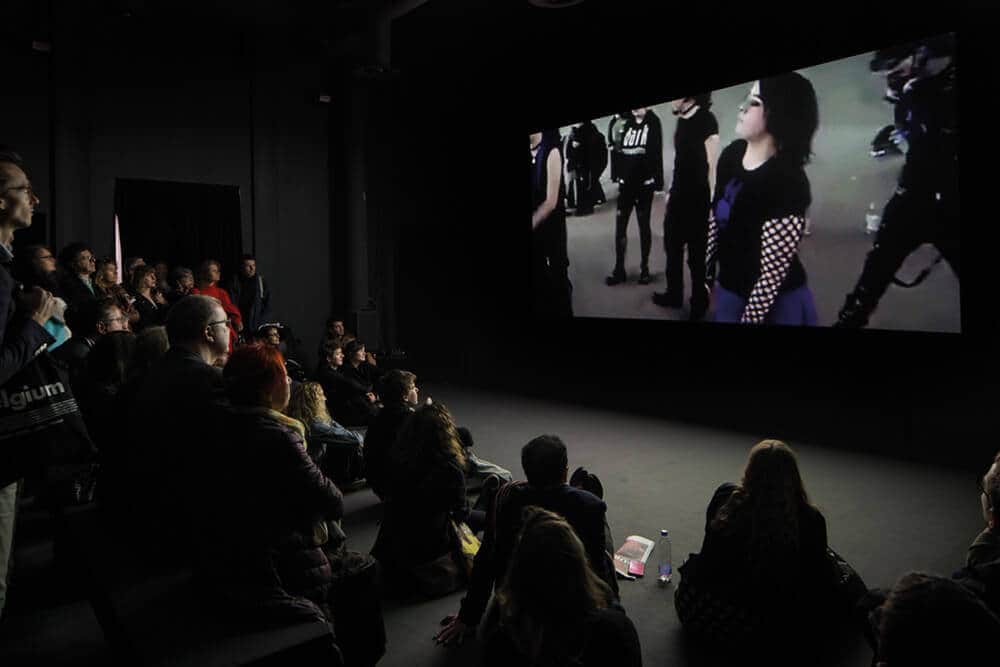 Arhtur Jafa, The White Album, 2019. Single channel video projection, colour, sound. Photographer:Francesco Galli. Courtesy of La Biennale di Venezia.
Arhtur Jafa, The White Album, 2019. Single channel video projection, colour, sound. Photographer:Francesco Galli. Courtesy of La Biennale di Venezia.
Jafa’s (b. 1960 USA, lives and works in Los Angeles) film won the Golden Lion for Best Participant in the International Exhibition ‘May You Live In Interesting Times’. Which in equal measure, is an essay, a poem and portraiture. Jafa uses appropriated and original footage to reflect upon issues of race. Just as the film critiques a moment fraught with violence, in tenderly portraying the artist’s friends and family, it also speaks to our capacity for love.
Since 2007, the controversial Africa Pavilion organised as part of Robert Storrs’ 52nd Biennale, and funded by collector Sindika Dokolo, there has been a motivated push to establish African national participation at La Biennale. Despite the enthusiasm, and while the push has initiated a number of new African pavilions, the number of national pavilions has remained small and inconsistent, with few countries being able to establish an ongoing presence.
Many in the art community are quick to blame the relevant African national governments for short-sightedly failing to recognise the importance of participation at Venice and choosing to prioritise their focus on cultural development within their countries. While this is important, participation in Venice is a very powerful mechanism to bring attention to the cultural richness of participating countries through the extensive global media that the La Biennale di Venezia receives.
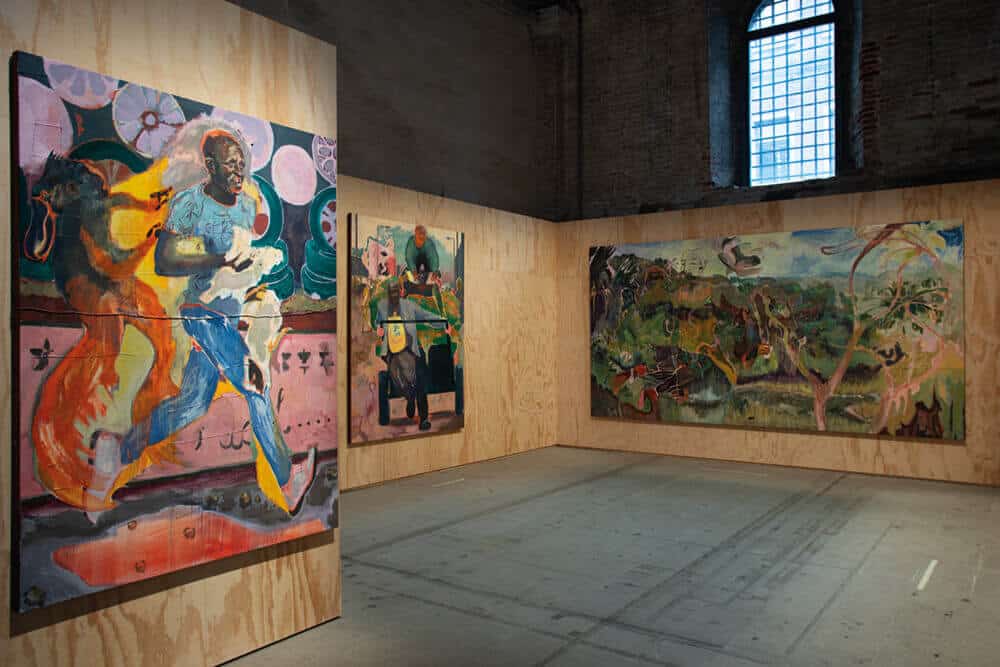 Michael Armitage, Various works, 2019. Oil on Lubugo bark. Photographer: Andrea Avezzù. Courtesy of La Biennale di Venezia.
Michael Armitage, Various works, 2019. Oil on Lubugo bark. Photographer: Andrea Avezzù. Courtesy of La Biennale di Venezia.
At the last La Biennale di Venezia, there were 8 African countries represented, with a few of them attending for the first time (Nigeria, Ivory Coast, Tunisia). This year none of these debutantes are there. Chike Okeke-Agulu attributes this to “the seeming lack of long-term vision by the authorities responsible for these initiatives. It is as if what’s important to them is to go first to Venice and then think about – if at all – a sustainable infrastructure for their pavilion.”
However, even where plausible neither of these criticisms is sufficient. To understand the value of Venice for Africa, and whether there is a value, one needs to understand the La Biennale di Venezia model and Venice in the context of the art ecology – and its vital place in the contemporary art market – without trite misdirection’s like the La Biennale di Venezia is the Olympics of the art world.
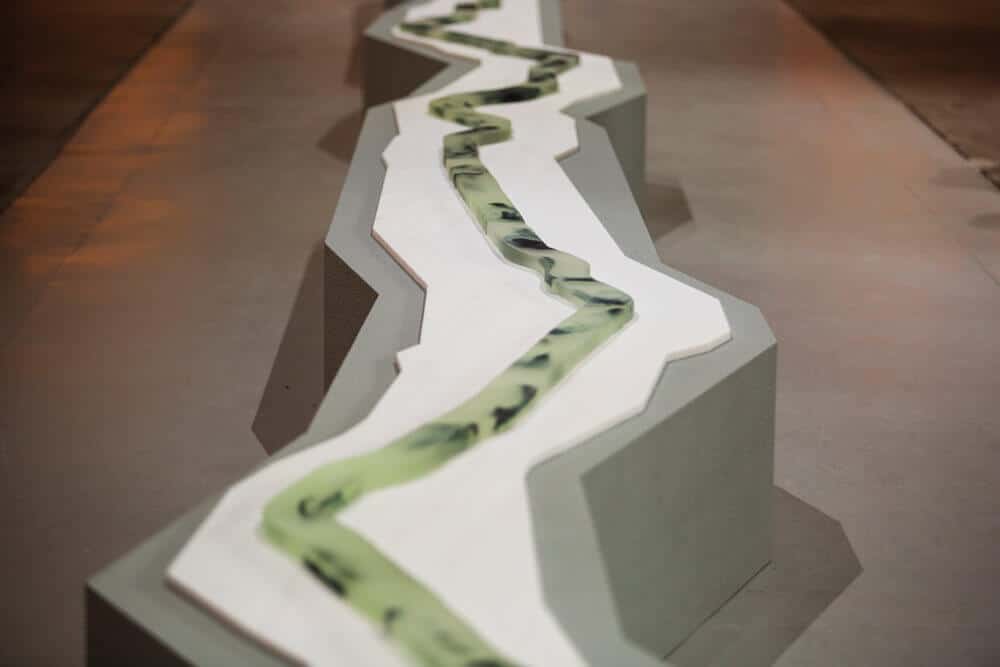 Otobong Nkanga, Various works, 2018. Mixed media. Photographer: Italo Rondinella. Courtesy of La Biennale di Venezia.
Otobong Nkanga, Various works, 2018. Mixed media. Photographer: Italo Rondinella. Courtesy of La Biennale di Venezia.
The cultural economist, Olav Velthuis in “The Venice Effect”, spells it out, “There’s this saying, ‘See it in Venice, buy it in Basel… Basel and Venice derive their central role in the art industry from the latter’s status-driven nature: both the Biennale and the fair are finely tuned tools that reflect and reproduce status hierarchies. They distinguish visitors by providing selected groups with VIP treatment, access to pre- (and pre-pre-) openings, after parties on expensive billionaire’s yachts, and visits to the villas of collectors living close by. Those types of access are broadly recognised as signs of status among the cultural elite: the more exclusive the venue, the more status access to that venue produces.”
The La Biennale di Venezia cannot exist without the art market, without a symbiotic relationship with galleries – and not just any galleries, but galleries which operate at a very specific stratum of the art market. These galleries fund the production of artworks which are expected to be sold and create new sales opportunities, and price increases for the relevant artists. This is not a new strategy or a secret.
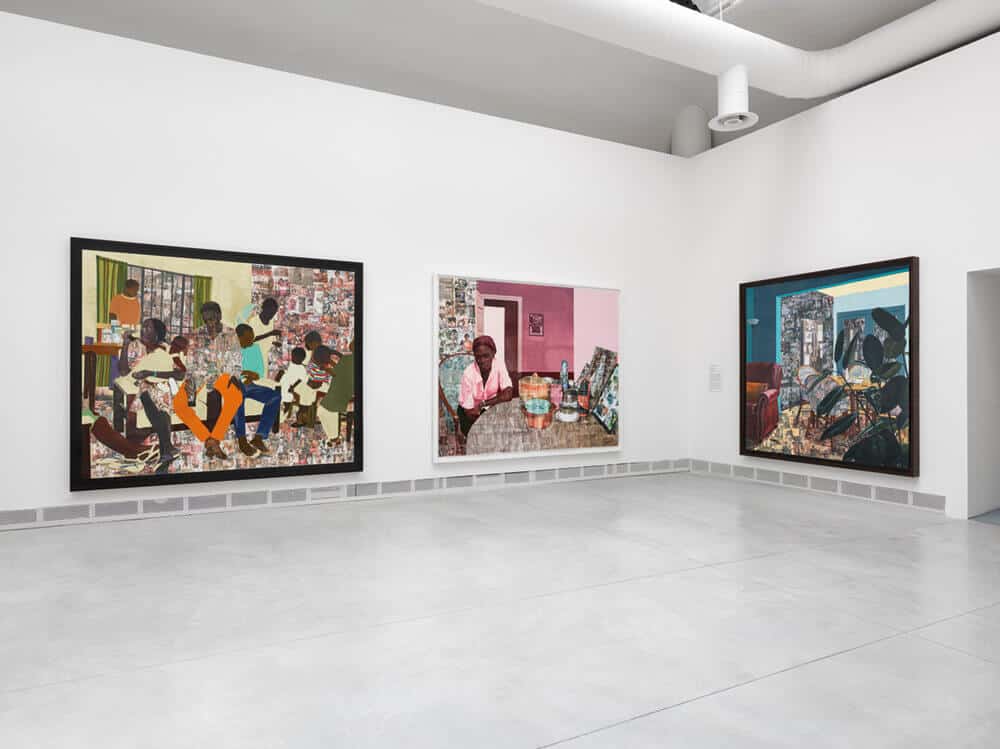 Njideka Akunyili Crosby, Various works, 2012-2017. Mixed media. Courtesy the artist, Victoria Miro, and David Zwirner.
Njideka Akunyili Crosby, Various works, 2012-2017. Mixed media. Courtesy the artist, Victoria Miro, and David Zwirner.
When celebrating African participation in Venice, we cannot be blind to the fact that fifty percent of all artists in the main curated exhibition, regardless of descent, come from just four cities, Berlin, New York, Los Angeles and Paris with 80% coming from the Global North. And, more than 80% of all artists are represented by galleries taking part in Art Basel and Frieze art fairs. Every African artist in the curator’s exhibition is in one or both of these categories. There is not a single African artist in Ralph Ruggof’s exhibition, who is not represented by a participating gallery at Art Basel.
So, while African national pavilions continue to try and get a foot in the door – the unspoken and open secret about why Africa remains on the fringe lingers. As a result, celebrations around new arrivals, perseverance, and continuity not only distract focus from the art, they also perpetuate the paternalistic view of African art by the international art establishment.
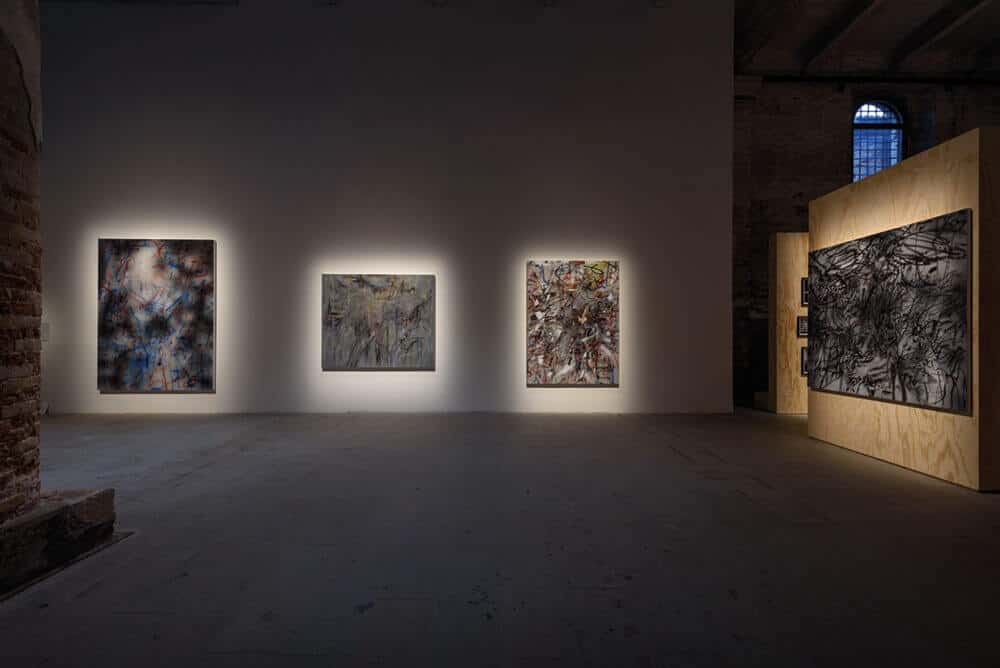 Julie Mehretu, Various works, 2017-2018. Ink and acrylic on canvas. Photographer: Andrea Avezzù. Courtesy of La Biennale di Venezia.
Julie Mehretu, Various works, 2017-2018. Ink and acrylic on canvas. Photographer: Andrea Avezzù. Courtesy of La Biennale di Venezia.
It also begs the question “Is this overpriced, compromised and elitist commercial forum really something that art sectors in Africa should aspire to at a time when they are struggling to build engagement within their own broader communities – and trying to grow awareness and appreciation for culture within the continent is imperative?”
This is why we can’t just talk about the art. Art does not exist in isolation of the effort of arrival; nor does it exist in isolation from domestic politics; nor the projection of nationalism of each participating country; and equally local art sectors cannot exist in isolation from their engagement in the international art market. This is unequivocally the case, not just for African participants, but for all nations participating at Venice – although Africans often appear to believe in separation between the market and Venice – which is simply impossible.
How can we talk about the art, when Ralph Rugoff is asked in an interview: “Are there Africans?”, referring to their participation, and answers “Yes, wonderful African artists, from Kenya, Ethiopia, Nigeria, and South Africa.” His five Africans include New York’s Julie Mehretu and L.A.’s Njedeka Akunyili Crosby respectively, who also enjoy major gallery representation, with their work commanding huge prices at international auctions. They have also benefited hugely from international art education and first-world infrastructure, benefits which artists living on the continent do not have access to. Regardless of the merit of their work, this is part of the terse context of any discussions around the art – not just in the curator’s exhibition – but also within the African national pavilions.
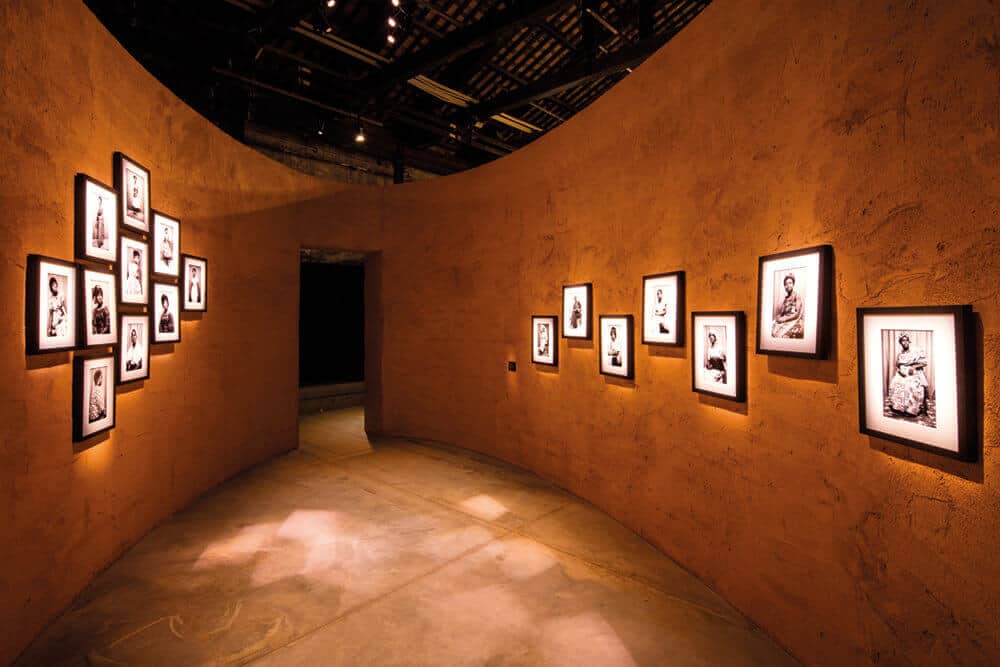 Felicia Abban, Untitled (Portraits and Self-Portraits), 1960-70. Digital images generated from original prints. 50 x 40cm. Courtesy the artist. Photograph: David Levene
Felicia Abban, Untitled (Portraits and Self-Portraits), 1960-70. Digital images generated from original prints. 50 x 40cm. Courtesy the artist. Photograph: David Levene
Ghana’s debut was anticipated as a spectacular all-star affair, with transcendent works by El Anatsui, superlative presentations by John Akomfrah, Lynette Yiadom-Boakye and Ibrahim Mahama and Selasi Awosi Sosu, with photography by Felicia Abban providing historical gravitas. The pavilion’s deterministic roundhouse architecture was delivered by starchitect David Adajaye. Equally evident was the presence of these artists’ gallerists – art world heavyweights – White Cube (London), Lisson Gallery (London), Jack Shainman Gallery (New York) and October Gallery (London) among other international players. Not only are they the key funders of these artists but they are also the true financial beneficiaries of Ghana’s national pavilion debut in Venice. As Velthuis says: “You are considered to be successful in the art market if your prices are rising quickly… and that is exactly what… biennale enables an artist and an art dealer to do.”
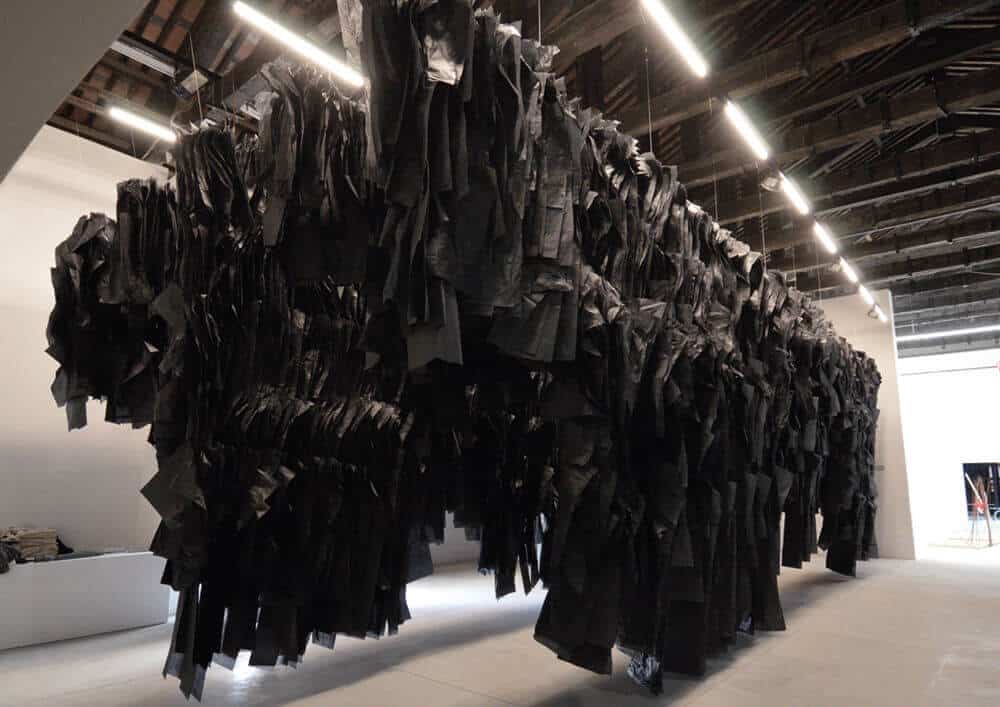 Joël Andrianomearisoa, I have forgotten the night, 2019. Paper collage and sound. Variable dimensions. ©Patrice Sour
Joël Andrianomearisoa, I have forgotten the night, 2019. Paper collage and sound. Variable dimensions. ©Patrice Sour
Similar awareness informed the first Madagascar Pavilion, an exceptional solo effort, produced almost entirely as a private venture collaboration between artist Joël Andrianomearisoa his gallerists and private supporters, with minimal state support and intervention, but with a well-educated understanding of how Venice works. Given the personal nature of the effort, one questions the chances for a Madagascar Pavilion in 2021.
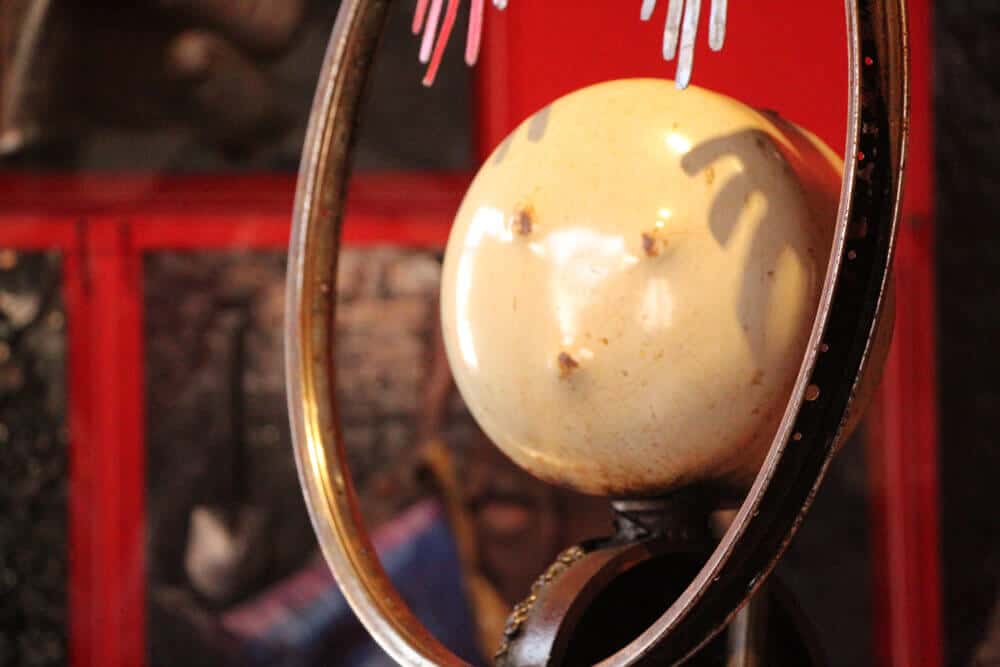 ©Pavilion of Mozambique 2019
©Pavilion of Mozambique 2019
The artists’ personal effort and determination were also manifest in the Mozambique Pavilion where Mauro Pinto and Gonçalo Mabunda spear-headed a small but impactful exhibition at Palazzo Mora with Pinto, Mabunda and Filipe Branquinho’s work. Their neighbours at the Seychelles Pavilion also put together an understated but tastefully assembled room of undulating embossed paper waves with an adjacent room dedicated to a video installation. Both, however, were subsumed in the cacophony of the Palazzo Mora, which rents out walls to hundreds of artists during the Biennale for a fee.
 Ananias Léki Dago, Rainy days, 2013-2018. 50 x 60cm. Courtesy of the artist.
Ananias Léki Dago, Rainy days, 2013-2018. 50 x 60cm. Courtesy of the artist.
Côte d’Ivoire’s approach was somewhat different, taking on a shopfront gallery on the Grand Canal and their collaboration featured the wonderful Ernest Dükü and Ananias Léki Dago, Valérie Oka – and puzzlingly a Chinese artist Tong Yanrunan. A tasteful exhibition but evidencing a lack of funds for executing a grand vision for the site-specific work, which is virtually de rigueur for La Biennale di Venezia pavilions.
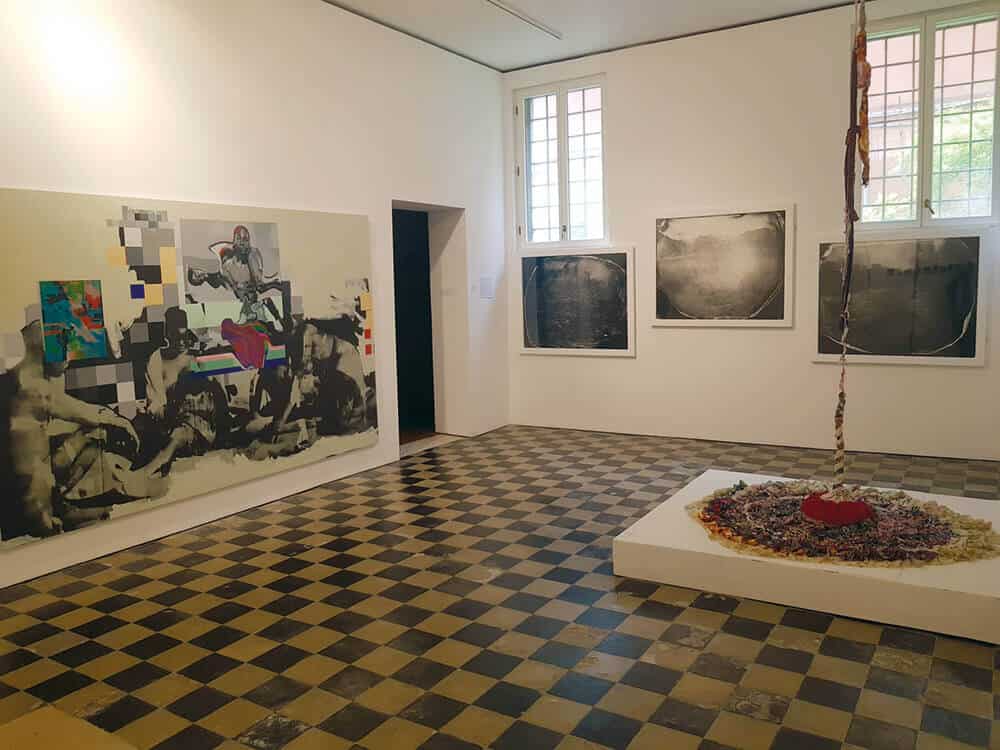 Installation view of Zimbabwe Pavilion; (from left-right) Kudzanai-Violet Hwami, Neville Sterling & Georgina Maxim.
Installation view of Zimbabwe Pavilion; (from left-right) Kudzanai-Violet Hwami, Neville Sterling & Georgina Maxim.
Similar constraints were at play for Zimbabwe, which celebrated consistency of participation with its fifth pavilion. It’s usual commercial gallery style group exhibition, saw major canvases by Cosmos Shiridzinomwa and UK’s Kudzanai Violet Hwami, competing for space with Regina Maxim’s textile installations and Neville Sterling’s print-based works and installation, all vying for attention in a scaled down venue.
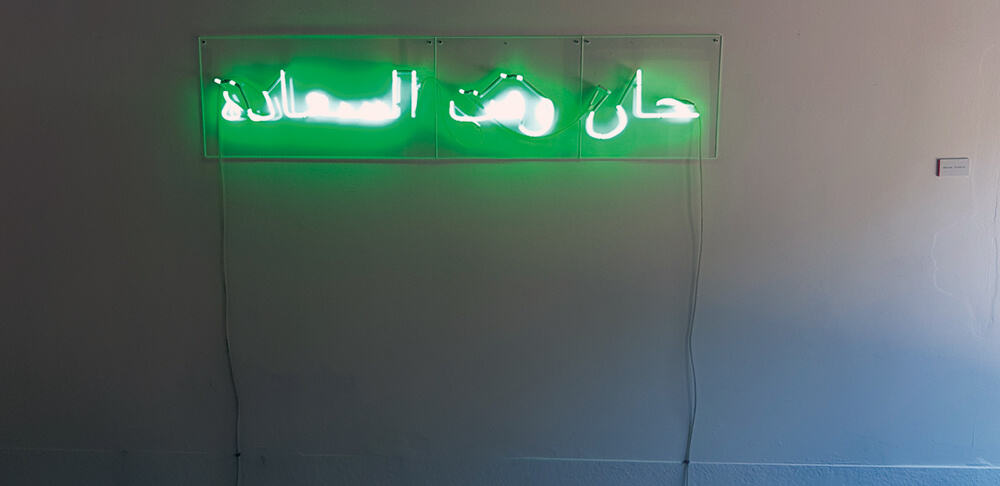 Amina Zoubir, Love all women like you love your mother, 2018. Neon installation, 120 x 30cm. Photographer: Marcus Gora.
Amina Zoubir, Love all women like you love your mother, 2018. Neon installation, 120 x 30cm. Photographer: Marcus Gora.
Like Kenya in 2017, Algeria’s participation was secured by the courageous efforts of artists and private supporters, and Amina Zoubir in particular, who braved government abandonment at the eleventh hour, and rallied to present a committed vision for Algeria with Zoubir’s neon text works and video.
Finally, Egypt, the only African pavilion in the gated community of the Giardini, where all the well-established countries at the La Biennale di Venezia have each built a home – presented an assemblage, revisiting – and not for the first time in recent history – sphinxes, pyramids, and obelisks with an almost high-tech angle, which aimed to impress but succeeded in bewildering instead.
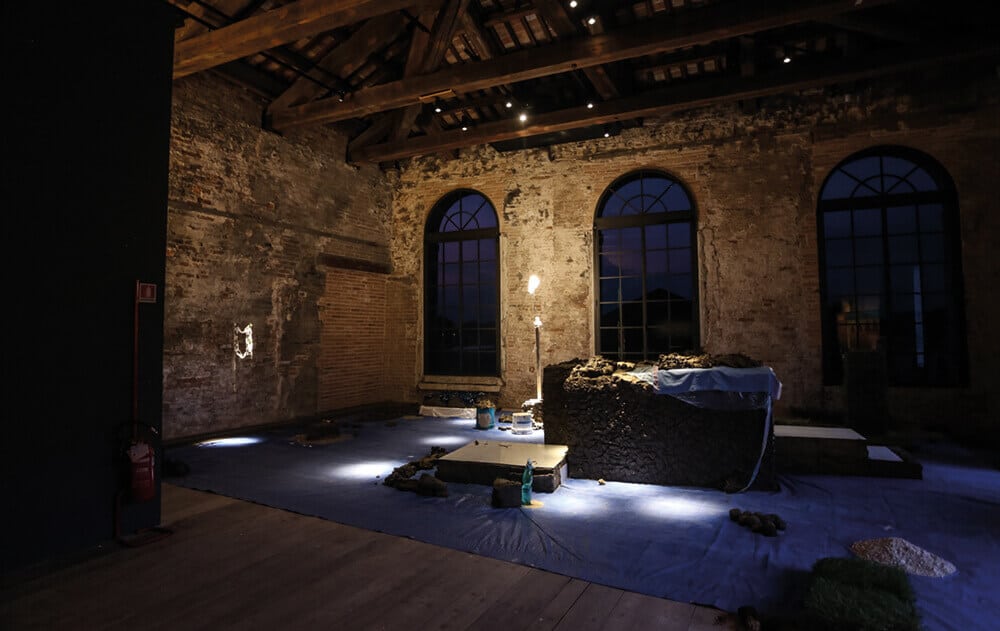 Dineo Sesee Bopape, Marapo a yona Dinaledi (Its bones the stars), Sketch no22, 2019. ©South Africa Pavilion
Dineo Sesee Bopape, Marapo a yona Dinaledi (Its bones the stars), Sketch no22, 2019. ©South Africa Pavilion
South Africa has cemented its spot in the Arsenale despite battling numerous domestic challenges to get to Venice. Their presentation seems the most well positioned to ticking all the right boxes for their longevity at Venice with all their artists, both in their national pavilion and the main exhibition, represented by Art Basel participating galleries with their pavilion presentation supported by professionalised PR and outreach programmes and a well-executed VIP dinner. South Africa’s sustainability is also in the works through a public-private collaboration by the ‘Friends of the South African Pavilion at the La Biennale di Venezia’ and accountability and transparency through an open tender process managed by the South African Department of Arts and Culture.
So, in order to make Venice work, Africa’s aspirants must be clear-eyed about the fact that the La Biennale di Venezia is a platform integrated entirely into the Western-centric art market and makes sense, operationally and economically, only in that context. Without such integration, no national African pavilion’s participation is going to be viable or ongoing. However, it also raises the question of national priorities.
What purpose does it serve to spend enormous sums of money on pavilions, when art schools across the continent are desperately underfunded, with graduate opportunities an exception and not the rule; when their museums don’t have budgets to build national collections; when they don’t have national gallery systems – or sufficient collectors and patrons to support, invest and celebrate their artists and national culture. What purpose does a pavilion serve when the best outcome a participating artist could hope for is to be picked up by a non-African gallery – which will ensure that the returns of the financial investment into the pavilion accrues to a non-African party.
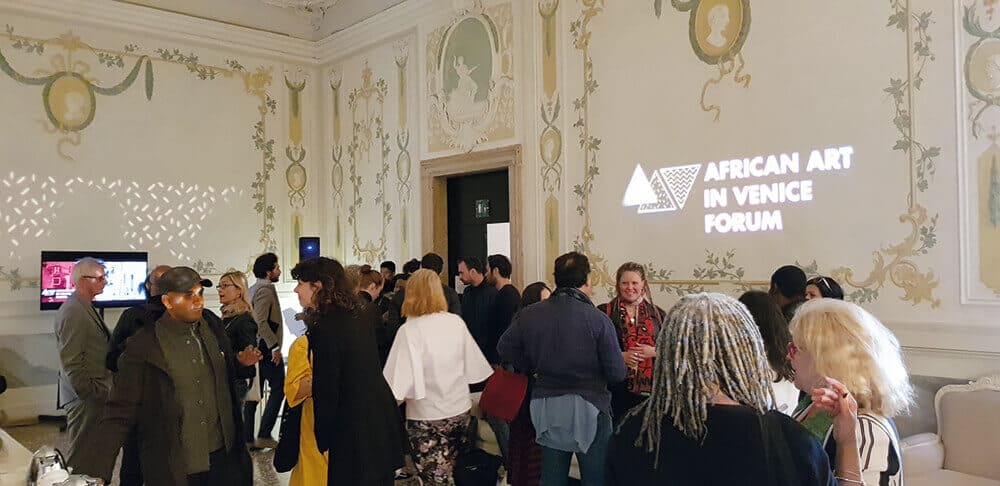 Participants & Audience mingling before ‘African Art in Venice Forum’ starts. The Forum took place 7-9 May 2019 at Hotel Monaco & Grand Canal Venice, Italy. Photographer: Marcus Gora
Participants & Audience mingling before ‘African Art in Venice Forum’ starts. The Forum took place 7-9 May 2019 at Hotel Monaco & Grand Canal Venice, Italy. Photographer: Marcus Gora
This understanding was clearly in mind when Janine Gaëlle Dieudji, senior curator at the Museum of African Contemporary Art Al Maaden (MACAAL) was asked at the African Art in Venice Forum (AAVF) if Morocco has any plans for a national pavilion. Her response was that the country is not yet ready to present at Venice and that it is MACAAL’s mission to assist in developing engagement with art and growing audiences at all levels of society. Avoiding the trap of euro-centric elitism MACAAL is introducing programmes like ‘Couscous and Art’, inviting local audiences to enjoy a lunch while learning about art at the museum – the traditional way of sharing in Morocco.
The importance of making it count at a national level was also driven home by artist Ibrahim Mahama during his talk at the AAVF. Mahama explained why he has invested his own money into building The Savannah Centre for Contemporary Art (SCCA), a multi-disciplinary project and exhibition space, with educational programming and residencies, in his home town of Tamale. Mahama further asserted that it was important for him to see that the money he makes from art sales can also be used to make a real difference in his local community – for surely it is absurd for sown jute sacks to be selling for hundreds of thousands of dollars, which brought the room to a standstill.
So, when Pliny the Elder said ‘Ex Africa Semper Aliquid Novi’ he meant that Africa leads and does not follow and African aspirations in Venice must be assessed in this light. We can choose Venice, when it is a useful and advantageous opportunity – but we should ask ourselves why, soberly and confidently.
Valerie Kabov is an art historian with focus on cultural policy and culture economics. She is the co-founder and director of Education and International Projects at First Floor Gallery, Harare.



